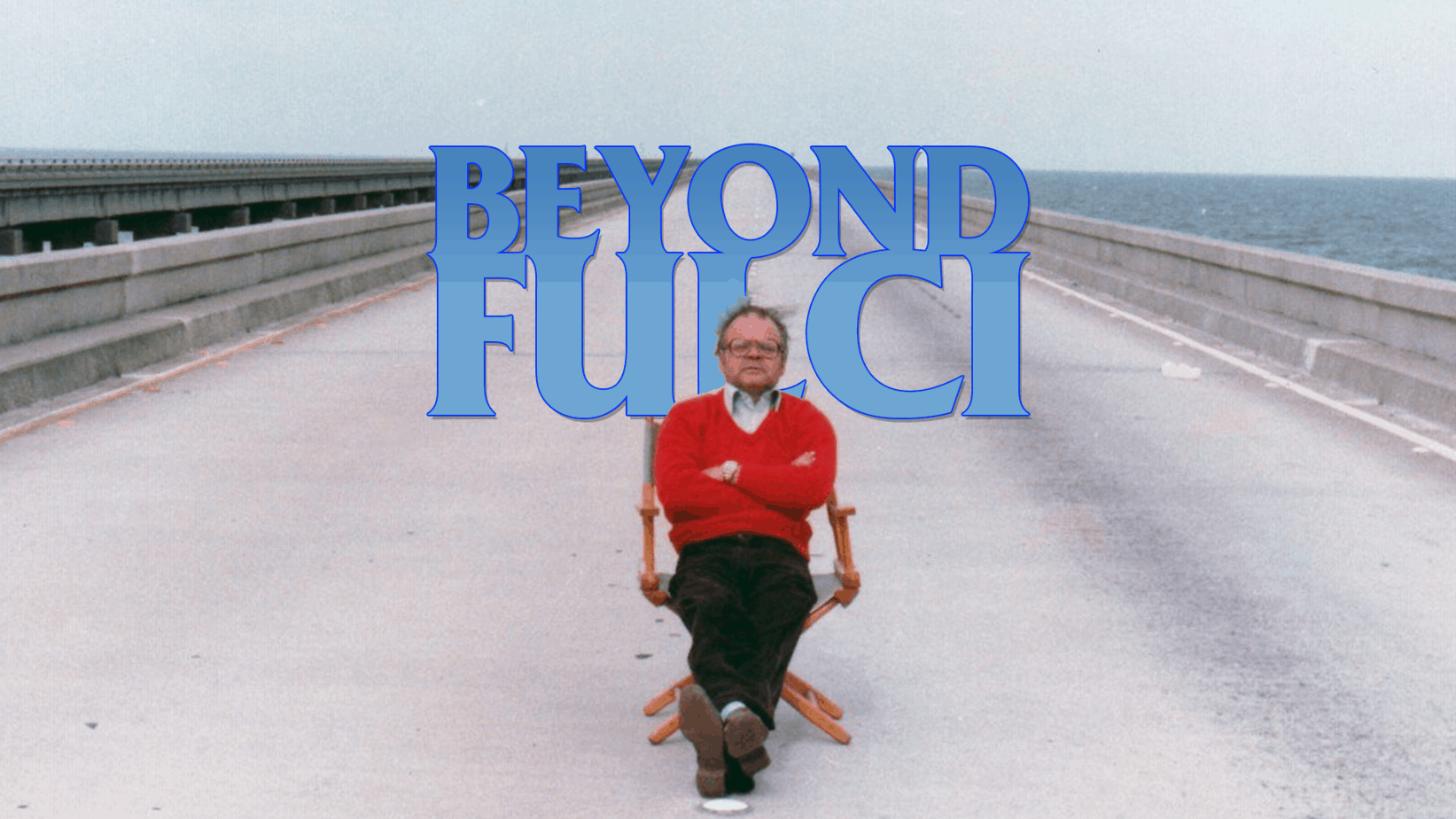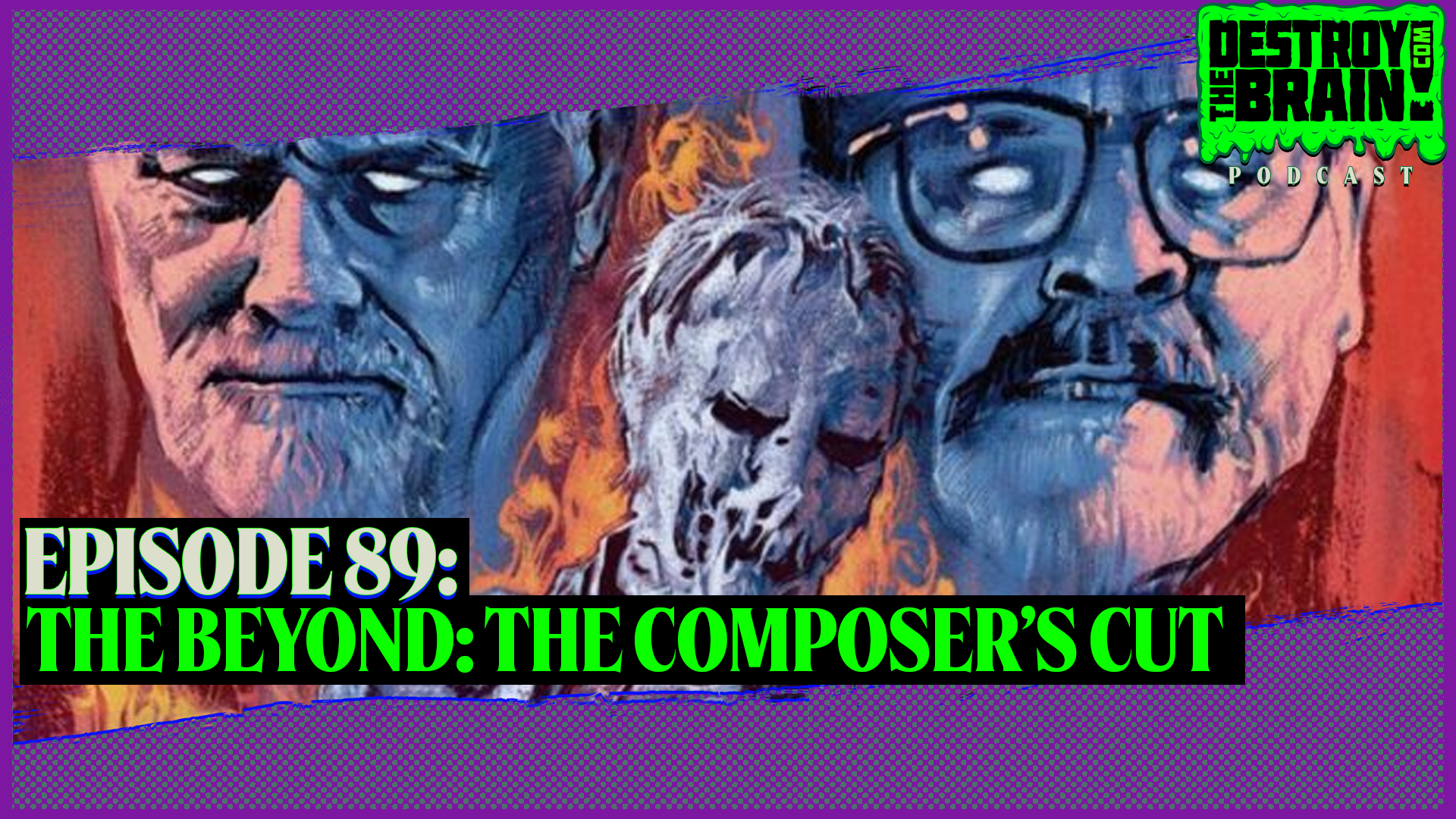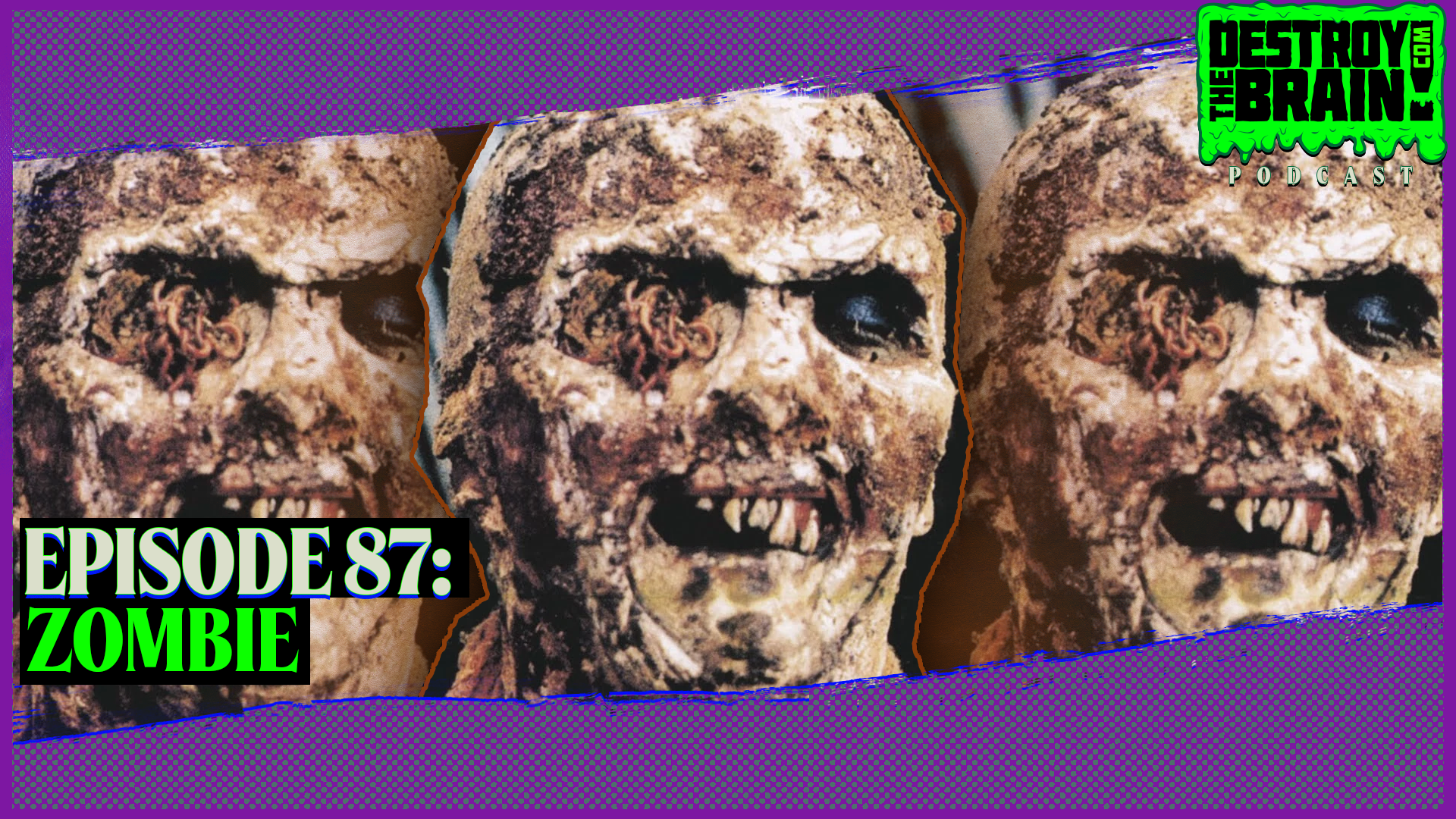
Beyond Lucio Fulci and ‘THE BEYOND’
The following is Andy’s “script” that he used for his seminar for Webster University Film Series’ month-long celebration on Lucio Fulci. Andy was invited to talk about Lucio Fulci’s The Beyond. Thank you to Pete Timmerman and Aaron AuBuchon for the invitation and for including me with other Fulci speakers like Kea Wilson, Aaron Christensen, Aaron Aubuchon, and Troy Howarth. You can access the other seminars via the Webster University Film Series’ YouTube channel. We have also included Andy’s recorded seminar. Of note, there were some audio issues on Andy’s end that are jarring at first but aren’t totally unlistenable. There are slight differences between what is scripted below and what is talked about in the recorded seminar. In addition, there is a Q&A in the recorded seminar that we embedded below that will not be found within the written portion of this post.
THE TRAGEDY OF LUCIO FULCI
Lucio Fulci, born in 1927, worked as an art critic while attending medical school. Fulci later dropped out of medical school and entered the Center of Experimental Film in Rome. He began making student documentary films in 1948 before moving into the Italian comedic film industry in the 1950s as a screenwriter. Lucio was married in 1958 and, in order to financially support his wife Marina and himself, he moved to direct comedies instead of just writing them which would garner them more income. Lucio and Marina would have two children, Camilla and Antonella. But in 1969, eleven years into their marriage, everything changed for Lucio Fulci’s personal life and some may say, myself included, it was the start of creating his film legacy for us horror fans.
In 1969, Marina Fulci sent her daughters Camilla and Antonella to the movies with her brother. She wanted to be alone and the house to be empty. While Camilla, Antonella, and Marina’s brother were at the theater, Marina turned on the gas for their household stove and stuck her head inside, thereby committing suicide. The little that has been documented on this simply states that Marina took her own life because she found out she had inoperable cancer. Something else that isn’t very well documented but briefly mentioned by those close with Fulci and on special features that are on Fulci’s physical media releases is that Lucio may have had a third daughter, possibly from a previous relationship prior to Marina, and that daughter was involved in a fatal car accident which also happened the same year his wife committed suicide.
In 1971, Lucio Fulci would direct the Giallo, A Lizard in A Woman’s Skin, and in the films to follow, Fulci would incorporate horror elements into his work before 1979’s Zombie (aka. Zombi 2/Zombie Flesh Eaters), which is his first straight horror film. One year later, Fulci would begin work on his horror filmography known as “The Gates of Hell” trilogy with City of the Living Dead (aka. The Gates of Hell). In 1981, just a year after “City”, Lucio would direct The Beyond and the final entry in the trilogy, House by the Cemetery. Since most of Fulci’s colleagues have said that for the remainder of his life, Lucio would often talk about how he missed his wife and wished he could have helped, this self-torture is more than likely what drove him to a darker side of cinema and would help cement his legacy in the horror genre.
BEYOND PRODUCTION
The Theatre of Cruelty has been created in order to restore to the theatre a passionate and convulsive conception of life, and it is in this sense of violent rigour and extreme condensation of scenic elements that the cruelty on which it is based must be understood. This cruelty, which will be bloody when necessary but not systematically so, can thus be identified with a kind of severe moral purity which is not afraid to pay life the price it must be paid.
— Antonin Artaud, The Theatre of Cruelty, in The Theory of the Modern Stage (ed. Eric Bentley), Penguin, 1968, p.66
Based on the financial success of Zombie, Fabrizio De Angelis provided Fulci with the creative and financial freedom to work on The Beyond. Even though there are three writers credited to writing the screenplay for the film, it is widely mentioned that there was no shooting script when they were filming.
The Beyond was actually filmed in New Orleans, Louisiana, something that was an odd locale for an Italian filmmaker as most Italian genre pictures took place in New York City. The reasoning behind that is Italian producers felt that if these genre films were set in New York City along with English voice dubbing that American audiences wouldn’t know the film was an import from Europe. Also, the majority of the audiences that were seeing these films were mainly interested in exploitative elements like violence, gore, and sexual content and would be watching these at a Drive-In with an “A-picture” or at a grindhouse if in Los Angeles or New York City with other films that explored these extreme elements.
When Fulci began scouting for locations for The Beyond he had the assistance of Larry Ray, who was a member of the Louisiana Film Commission in addition to being a New Orleans resident and someone who could speak fluent Italian, which came in handy as Lucio didn’t know any English and would essentially mime the actions for the non-Italian speaking actors in his direction. Because Larry Ray did so much for the production with the locations, Fulci hired him to help out with the production by giving him the roles of Production Manager and Producer’s Assistant in addition to giving him the role of Larry, the poor unfortunate painter who falls off the scaffolding at the beginning of the story. To avoid any conflict with the Louisana Film Commission, Fulci credited him as Anthony Flees.
Lucio would cast British actress Catriona MacColl who would star in the whole “Gates of Hell” trilogy and would be one of the very few actresses that Fulci could tolerate. Lucio was known to be pretty harsh to his actors but especially more harsh to his female actors. MacColl talks positively in interviews about Lucio but usually will tell you that he was not an easy director or an actor’s director. Some believe that this anger towards actresses was the result of the lack of closure with Marina’s suicide and the fact that while Lucio wasn’t in control of that real-life event that he was perhaps controlling and overbearing with his actresses to gain a sense of personal control.
GOING INTO THE BEYOND
I’m a man who searches for God and who has doubts. Buñuel was a man who sought God desperately without any doubts.
— Lucio Fulci, Interview from Spaghetti Nightmares (ed. Luca M. Palmerini and Gaetano Mistretta), Fantasma Books, 1996, pg.62
Lucio Fulci’s The Beyond is considered the masterpiece of his filmography and while I personally teeter between this or City of the Living Dead, there is no denying that Fulci is in complete control of this film. Does it completely make sense? No. Is it for every horror fan? No. Should every horror fan have seen this film? Yes. Fulci’s The Beyond is a cinematic manifestation of a nightmare. It is for this reason that the film doesn’t have to make sense as I’m sure all of us can say that not everything makes sense in our dreams or nightmares but we typically remember striking images or feelings evoked in our moments of slumber. What Fulci’s The Beyond addresses is the fear of the unknown and the afterlife, “The Great Unknown”. While the viewer isn’t given tons of information, one the most frightening scenes for me is the scene with Emily (with the actress credited as “Sarah Keller”, an obvious play on Helen Keller) and her dog Dickey. Upon reaching the end of the film, we realize that Emily found a way to get out of “The Beyond” or “The Afterlife” and return to the normal world however it didn’t last long as she gets surrounded by beings that stand there waiting to “collect” her as she pleads that she doesn’t want to go back. Not to mention, Emily can’t see a damn thing but she knows they are there in the room with her. After she sicks Dickey on the supernatural beings and Dickey has their blood on his head, Dickey then turns and savagely rips apart Emily. It’s a very visceral scene in that it touches upon that there is no escape from the inevitable but on a very simple level, the supernatural element in this film doesn’t just haunt the hotel but it can control a pet, a symbol to be man’s best friend, and control it to destroy in the blink of an eye.
The film is filled with images and shots, thanks to Sergio Salvati’s excellent and dream-like cinematography. Unlike Dario Argento or Mario Bava, Fulci only cares about evoking mood and reactions to the images he is forcing onto the audience and not a garish or arresting color palette. To lend to more of the nightmarish feel of The Beyond there are exaggerated sequences like a 3-minute spider attack scene where we, as an audience, are paralyzed to watch painfully slow spiders slowly rip away a man who has been physically paralyzed by a fall. The spider’s movements crinkle and low droning sounds along with faint moans and screams definitely amplify Giannetto De Rossi’s makeup effects that are displayed on the screen. Fulci may be on the nose with this sequence but after the movie is done no one will forget it and it is based purely on the images we are shown and the feeling evoked.
BEYOND THE DISTRIBUTION
The Beyond, even though it was filmed and takes place in America, didn’t hit American theaters until 1983 via a truncated version called 7 Doors of Death. The U.S. distributor, Terry Levine of Aquarius Releasing, felt that the film had the exploitive elements needed but also felt the film’s pacing would be too slow for American audiences looking for a thrill in Drive-In’s and grindhouses. Fabio Frizzi’s excellent score was replaced, several minutes were cut in order to get an R-Rating and the end product that ended up on our shores paled in comparison to what Fulci was trying to complete with his vision. Levine, the showman that he was, knew that he had to find a way to appeal to American audiences. He capitalized by using a film that had come out 9 years prior and made such an impact on the genre and exploitation film. That film was The Texas Chain Saw Massacre. Levine screened it for Tobe Hooper and Kim Henkel, the creative forces behind The Texas Chain Saw Massacre after Levine purchased the U.S. distribution rights for around $35,000 and spent an additional $10,000 on additional post-production work. Hooper and Henkel liked the film and since Hooper just came off doing Poltergeist, Levine decided to get some quotes from Hooper and Henkel and slap them on the advertising campaign of the 7 Doors of Death release. Coupled with this and some double billing of Levine’s own distributed title, Dr. Butcher M.D., 7 Doors of Death was a box office success and ended up grossing $455,652 during its first week of release. Levine has estimated that the film turned him a profit of roughly $700,000.
GOING BEYOND THE BEYOND
Lucio Fulci never experienced the success that Dario Argento had on American shores and Fulci has often targeted Dario Argento in trash talking. This could be due to the worldwide success of Dario Argento whereas many Italian genre filmmakers like Fulci, Mario Bava, Sergio Martino, and others had more filmmaking experience within the genre and also outside the genre. Lucio Fulci personally felt that Dario Argento benefitted from his father’s success as a producer and distributor as opposed to actually earning the success. Argento’s Bird with the Crystal Plumage was heavily marketed as a thriller in line with Alfred Hitchcock’s Psycho and was in fact named by the American press as the “next Hitchcock”. Fulci’s health would deteriorate into the late ’80s and into the ’90s. In January 1996, he made his only public appearance at Fangoria’s Weekend of Horrors in New York City. Fulci had no clue what was going to happen but even in his declining health entertained the request to come to America for an appearance. When he arrived at the convention, he was floored that he was being treated like a celebrity and he was treated as such among the gorehounds that religiously read Fangoria and Gorezone. Keep in mind The Beyond, Fulci’s masterpiece was only available uncut via VHS Bootlegs or through the heavily truncated, compromised 7 Doors of Death cut.
While Fulci was not a fan of Dario Argento, possibly because of Argento’s success, Dario never had any issue with Lucio Fulci and knew that Fulci had a very tough career coupled with the loss of his wife that Argento used some of his power to try and get Fulci to make a film called Wax Mask in 1994 that Argento would produce in hopes of giving Fulci a comeback. Sadly, Lucio Fulci passed away on March 13, 1996 – just two months after his American Fangoria appearance.
The Beyond would be released uncut, restoring Fulci’s original vision, thanks to Quentin Tarantino’s Rolling Thunder Pictures – a release arm that was assisted by Miramax due to Tarantino’s financial and pop culture success – and Grindhouse Releasing in 1998 via midnight screenings. The Beyond was introduced to a new audience (myself included as I didn’t see the film until the mid-2000s).


